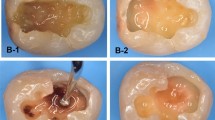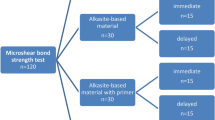Key Points
-
ART is a successful method that uses glass ionomer cement to control decay.
-
Although ART has good success rates, it is not known how ionometric material can affect dentine structure.
-
Microhardness studies may help investigations of tooth structure alterations like remineralisation and demineralisation.
Abstract
Objective To evaluate the microhardness of dentine underlying glass ionomer restorations made with Atraumatic Restorative Treatment.
Design An experimental single-centre study.
Setting University Department, Brazil, 2001.
Materials and Methods Sixteen children were selected showing primary molars containing carious cavities (n=29), which were restored using Fugi IX. Subsequently, some teeth were extracted respecting Nolla stage 7 or 8 of the permanent successor, and categorised according to the post-restoration time in the mouth: G1 (baseline, immediate extraction), G2 (30 days), G3 (90 days) and G4 (180 days). Four teeth were excluded because they were not in time of normal exfoliation. The 25 extracted teeth were resin embedded, sectioned mesiodistally and prepared metallographically. Knoop microhardness analysis (Micromet 2003; 10g for 1.5 sec.) produced identations in three areas of dentine: Zone 1 (just below the restoration), Zone 3 (as close as possible to the pulp) and Zone 2 (intermediate region between 1 and 3). Non-parametric statistical tests were done — at a significance level of 5%.
Results Four teeth were excluded. No significant difference was noted among the zones, inside the groups. Zones 1 and 2 showed a considerable increase of microhardness according to the time, except for Group 3 (p>0.05).
Conclusion Although microhardness had increased, it was not sufficiently equal to the microhardness of the healthy dentine, regardless of the depth evaluated.
Similar content being viewed by others
Log in or create a free account to read this content
Gain free access to this article, as well as selected content from this journal and more on nature.com
or
References
Ewoldsen N, Covey D and Lavin M . The physical and adhesive properties of dental cements used for atraumatic restorative treatment. SDC Special Care in Dentistry 1997; 17: 19–24.
Phantumvanit P, Songpaisan Y, Frencken JE, Pilot T . Atraumatic restorative treatment technique - Evaluation after one year. J Dent Res 1995; 73: 1006, Abst. No. 30.
Phantumvanit P, Songpaisan Y, Frencken JE, Pilot T . Atraumatic restorative treatment technique - Evaluation after two years. J Dent Res 1995; 73: 1014, Abst. No. 24.
Smales RJ, Yip HK . The atraumatic restorative treatment (ART) approach for the management of dental caries. Quintessence Int 2002; 33: 427–432.
Phantumvanit P, Songpaisan Y, Frencken JE, Pilot T . Atraumatic restorative treatment (ART): Evaluation after two years. p 53. WCPD'95 Official Program, 1995.
ten Cate JM, van Duinen RNB . Hypermineralisation of dentinal lesions adjacent to glass-ionomer cement restorations. J Dent Res 1995; 74: 1266–1271.
Samuel SMW, Rubinstein C . Microhardness of enamel restored with fluoride and non-fluoride releasing dental materials. Braz Dent J 2001; 12: 35–38.
Smales RJ, Gao W . In vitro caries inhibition at the enamel margins of glass ionomer restoratives developed for the ART approach. J Dent 2000; 28: 249–256.
Wandera A . In vitro enamel effects of a resin-modified glass ionomer: fluoride uptake and resistance to demineralisation. Pediatr Dent 1998; 20: 411–417.
Mount GJ . Some physical and biological properties of glass ionomer cement. Int Dent J 1995; 45: 135–140.
Lyre WR, Johnson ON . Essentials of dental radiography for dental assistants and hygienists. pp 231–250. Norwalk: Appleton & Lange, 1995.
Nolla CM . The development of permanent teeth. J Dent Child 1960; 4: 254–266.
Pilot T, Frencken J, Phantumvanit P, Songpaisan Y . A prevention oriented oral care system for rural and underprivileged population. Adv Dent Res 1995; 9: 155.
Craig RG . Restorative dental materials. pp 54–105. St. Louis: Mosby, 1993.
Kodaka T, Debari K, Yamada M, Kuroiwa M . Correlation between microhardness and mineral content in so und human enamel. Caries Res 1992; 26: 139–141.
Craig RG, Peyton FA . The microhardness of enamel and dentin. J Dent Res 1958; 37: 661–668.
Meredith N, Sherriff M, Setchell DJ, Swanson SAV . Measurement of the microhardness and young's modulus of human enamel and dentine using an indentation technique. Arch Oral Biol 1996; 41: 539–545.
Craig RG, Gehring PE, Peyton FA . Relation of structure to the microhardness of human dentin. J Dent Res 1959; 38: 624–630.
Smith DC, Williams DF . Biocompatibility of dental materials. Volume I. pp 75–95. Florida: CRC Press, 1982.
Gao W, Smales RJ, Yip HK . Demineralisation and remineralisation of dentine caries and the role of glass-ionomer cements. Int Dent J 2000; 50: 51–56.
Carvalho AS, Cury JA . Fluoride release from some dental materials in different solutions. Oper Dent 1999; 24: 14–19.
Six N, Lasfargues JJ, Goldberg M . In vivo study of the pulp reaction to Fugi IX, a glass ionomer cement. J Dent 2000; 28: 413–422.
Metz-Fairhurst EJ, Curtis JW, Ergle JW, Rueggeberg FA, Adair SM . Ultraconservative and cariostatic sealed restorations: Results at year 10. J Am Dent Assoc 1998; 129: 55–66.
van Amerongen W E . Dental caries under glass ionomer restorations. J Public Health Dent 1996; 56: 150–154.
Acknowledgements
The authors are grateful to the Mechanical Testing Laboratory of the Military Engineering Institute of Rio de Janeiro, RJ, Brazil, for its cooperation through specialist Leonardo F. Cruz.
Author information
Authors and Affiliations
Corresponding author
Additional information
Refereed paper
Rights and permissions
About this article
Cite this article
Santiago, B., Ventin, D., Primo, L. et al. Microhardness of dentine underlying ART restorations in primary molars: an in vivo pilot study. Br Dent J 199, 103–106 (2005). https://doi.org/10.1038/sj.bdj.4812525
Received:
Accepted:
Published:
Issue date:
DOI: https://doi.org/10.1038/sj.bdj.4812525
This article is cited by
-
Microbiological and SEM assessment of atraumatic restorative treatment in adult dentition
Clinical Oral Investigations (2021)
-
ART class II restoration loss in primary molars: re-restoration or not?
European Archives of Paediatric Dentistry (2010)
-
A popular misconception
British Dental Journal (2005)



